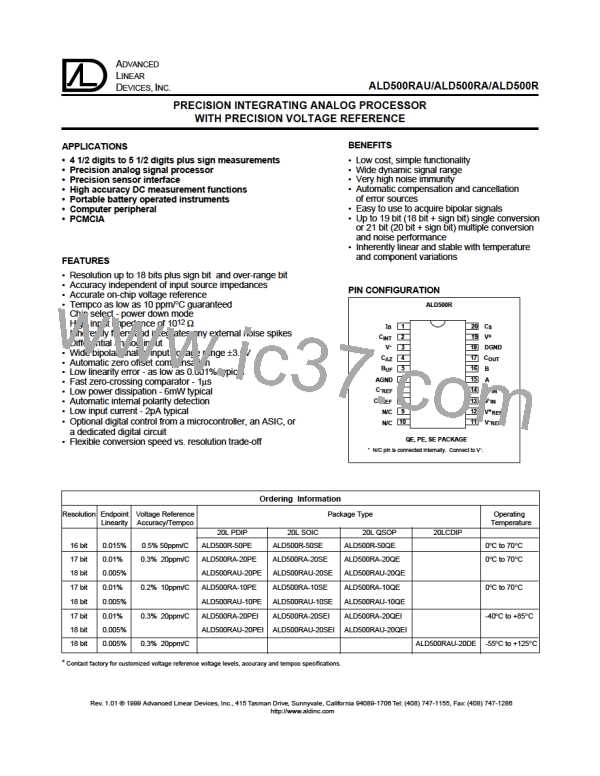3. Pick V MAX = ±2V
IN
Design Example 4:
Objective: 5 1/2 digit + sign +over-range measurement.
For I MAX = 20µA, applying equation (4),
B
1. Pick t
= 133.333 msec. for 60Hz noise rejection.
INT
2
R
=
= 100 KΩ
INT
(16.6667 msec. x 8 cycles)
Frequency = 1.8432 MHz
clock period = 0.5425 µsec.
-6
20x10
4. Calculate, using equation (3) for C
-6
:
INT
C
= (0.1) x (20 x 10 /4)
~
INT
During Input Integrate Phase,
(assume V MAX = 4V)
= 0.5 µF
INT
-3
133.333 x 10
total count =
-6
0.5425 x 10
Use C
INT
0.47µF as the closest practical value.
= 245776
5. Pick C
and C = 0.47 µF
AZ
REF
For V
= 4.0V, the basic resolution is
INT
6. Pick t
= 2 x t
= 200 msec.
INT
DINT
4
or 16.276 µV/count
245776
7. Calculate the value for V
, from equation (10):
REF
For V MAX = 2.00V, the input resolution is
IN
.
.
V
REF
=
C
V
MAX
R
INT
V
MAX
INT
INT
IN
16.276
x
= 8.138 µV/count
V MAX
INT
t
MAX
DINT
-6
3
0.5 x 10 x 4 x 100 x 10
2. Pick V range = ± 2V
IN
=
-3
200 x 10
2
= 100 KΩ
For I = 20 µA, R
INT
=
B
= 1.00V
-6
20 x 10
~
-6
= (0.133333) x (20 x 10 )/4 = 0.67 µF
3. Calculate C
INT
Design Example 3:
4. Pick C
REF
= C = 0.67 µF
AZ
1. Pick resolution of 18 bit. Total number of counts during
t
is 262,144.
5. Select t
DINT
= 2 x t
= 266.667 msec.
INT
INT
2. Pick t
= 16.66667 msec. x 10 cycles
= 0.1666667 sec.
6. Calculate V
as shown in Design Example 1,
INT
REF
substituting the appropriate values:
.
.
R
INT
C
V
MAX
INT
INT
MAX
V
=
This t
allows clock period of 0.5425 µsec.
REF
INT
and still achieve 18 bits resolution.
t
DINT
~
= 1.005V
3. Again, as shown from previous example, pick V MAX = ±2V
IN
2
For I MAX = 20 µA,
R
=
INT
= 100 KΩ
B
-6
20x10
4. Next, we calculate C
INT:
-6
C
INT
= (0.1666667) x (20 x 10 )/4
~
(V MAX = 4.0V)
INT
= 0.83 µF
In this case, use CINT = 1.0 µF to keep
V
INT
< 4.0V
5. Pick C
and C = 1.0 µF
AZ
REF
6. Select t
DINT
= 2 x t
= 333.333 msec.
INT
7. Calculate V
as shown in the previous examples
REF
= 1.00V
and V
REF
12
Advanced Linear Devices
ALD500RAU/ALD500RA/ALD500R

 ALD [ ADVANCED LINEAR DEVICES ]
ALD [ ADVANCED LINEAR DEVICES ]